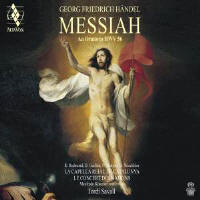Texte paru dans: / Appeared in: |
|
|
Reviewer: Huntley
Dent After the advent of period-practice Messiahs in the 1960s, a bewildering variety of versions has proliferated. Every aspect of traditional performance was suddenly malleable, so that by now a new interpreter like Jordi Savall has free rein to follow his own notions of tempos, embellishments, instrumentation, and vocal types. But he has resisted the temptation to mix and match, preferring historical purity instead. This live performance from the Chapelle Royale at Versailles is based on the 1741 autograph score in the British Library, the aim being to reproduce as closely as possible the work’s Dublin premiere. The only emendation are the revised oboe parts taken from part-books in 1754.
These niceties will probably
make little difference to a general listener, who will get the (accurate)
impression that a by now standard approach is presented, with Baroque
styling, a small complement of instruments, and chamber chorus. Also evident
is Savall’s dependable musicality. Unexpectedly he takes mostly traditional
tempos (with exceptions like a sped-up “The people that walked in darkness,”
which strolls along briskly), and his phrasing is rounded and warm. Given
his exalted reputation and sizable discography, Savall postponed Messiah for
a long while; he was 76 at the time of this performance.
Perhaps a decline in energy or
else a mellowed view of the score accounts for the mildness of Savall’s
reading. There is reduced drama compared with what I expected, or in
comparison with another European-based Messiah, from William Christie (Harmonia
Mundi). His forces were French, Savall’s Catalonian. Nothing is sloppy or
errant, however. Throughout the playing by selected members of Savall’s Le
Concert des Nations exhibits a lovely, gentle sonority featuring feathery
string attacks and an almost lulling mellifluousness. The choruses are
expertly sung by another Savall regular, La Capella Reial de Catalunya,
again performing in a noticeably gentle style. No one can be faulted for finding this comfortable approach a surprise coming from such an innovator in early and Baroque music. I didn’t have access to the booklet, and I hope I am not stepping on the toes of anyone’s reputation, but Savall’s four vocal soloists (in place of Handel’s nine) are often subpar. Not only are none of them truly memorable, but there are marked faults. Tenor Nicholas Mulroy has a weakly supported tone that limits his dynamic range, along with a timbre I found decidedly unpleasant. His only real asset is fluidly delivered ornamentation. The same can’t be said of countertenor Damien Guillon, who seems altogether like a mediocrity, strange to say in our age of countertenor glory. Soprano Rachel Redmond sets a higher standard. She has a pleasing tone and excellent Baroque technique, handling “Rejoice greatly” effortlessly with added decoration. Bass Matthias Winckhler has a light, flexible voice, which he handles nicely, although his arias are delivered with little authority.
All four
soloists suffer, moreover, from a woeful lack of expression. I could barely
detect what emotion they were supposed to be conveying. Even a simple
churchy reverence is absent, and given that Messiah was a theater piece,
there should be much more drama in the aria singing and choruses as well. If
we limit comparison solely to Christie, his vocal soloists are among the
best, if not the very best, of the HIP crop. The lineup features really
notable voices: Sandrine Piau, Andreas Scholl, Mark Padmore, and Nathan
Berg. They raise Christie’s highly dramatic (and sometimes idiosyncratic)
version to the top of my list among period Messiahs. There are some foreign
accents, which I easily adapted to; Savall’s forces are about equal in that
regard. The physical product here is two SACDs, and the engineering is
excellent for balance and impact. But the performance needs a great deal
more energy to achieve liftoff. Recommended only to Savall collectors, and
then with caution. | |
|
|
|
|
|
|
|
Cliquez l'un ou l'autre
bouton pour découvrir bien d'autres critiques de CD |
|




